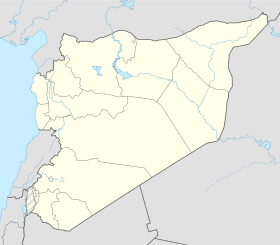Sarmada
Sarmada
سرمدا | |
|---|---|
| Coordinates:36°11′N36°43′E/ 36.183°N 36.717°E | |
| Country | |
| Governorate | Idlib |
| District | Harem |
| Subdistrict | al-Dana |
| Population (2007 est.) | |
| • Total | 15,000 |
| Time zone | UTC+2(EET) |
| • Summer (DST) | UTC+3(EEST) |
Sarmada(Arabic:سرمدا) is a town in theHarem District,Idlib GovernorateofSyria.[1]It is in the extreme northwest of Syria near the border withTurkey.
A church was consecrated in Sarmada byPatriarch Elias of Antiochin 722 CE.[2]It is also the place in which theBattle of Sarmadatook place between thePrincipality of Antiochand theArtukidson June 28, 1119.
Monuments
[edit]Column of Sarmada
[edit]The town is distinguished by theRomantomb of Alexandras, dated to the second century CE.[3]The tomb is rectangular and supports two columns, composed of thirteen cylicrical stones, joined together at the tenth cylinder by a horizontal piece with a furthercapitalon top.[4]
Monastery of Saint Daniel and Hisn ad-Dair
[edit]TheMonastery of Saint Daniel(also known asBreijorBraijoral-Breij) is located 2 km west of the town, perched in a hillside location about 400 metres from the road.[5]The monastery is dated to the 6th century CE during the later monastic phase of theDead Cities.[6]
A monastery calledHisn ad-Dairnear Sarmada was given to Alan of Gael byBaldwin II of Jerusalemin 1121 AD, when it was described as a fortified monastery.[7]There is also mention of acastlewith threewatchtowersin the area.[8]
Roman temple
[edit]A further 4 km along the road towardsBaqirhais aRoman templededicated toZeus.Epigraphicevidence was found dating the structure to c. 169 CE. The temple features a massive gateway andcellaalong with one surviving column of what once was a four columnedportico.[6]
References
[edit]- ^Sarmada;Esyria
- ^Jan J. Ginkel;Hendrika Lena Murre-van den Berg;Theo Maarten Van Lint (2005).Redefining Christian Identity: Cultural Interaction in the Middle East Since the Rise of Islam.Peeters Publishers. pp. 1–.ISBN978-90-429-1418-6.Retrieved9 October2012.
- ^Warwick Ball (2000).Rome in the East.Taylor & Francis. pp. 363–.ISBN978-0-415-11376-2.Retrieved9 October2012.
- ^Soubhi Saouaf (1957).Six tours in the vicinity of Aleppo; visitors' guide.Georges Salem.Retrieved9 October2012.
- ^Diana Darke (2010).Syria, 2nd.Bradt Travel Guides. pp. 200–.ISBN978-1-84162-314-6.Retrieved9 October2012.
- ^abAndrew Beattie; Timothy Pepper (2001).The Rough Guide to Syria.Rough Guides. pp. 2–.ISBN978-1-85828-718-8.Retrieved9 October2012.
- ^Thomas S. Asbridge (2000).The Creation of the Principality of Antioch, 1098–1130.Boydell & Brewer Ltd. pp. 82–84, 88, 161.ISBN978-0-85115-661-3.Retrieved9 October2012.
- ^Hugh N. Kennedy (2006).Muslim Military Architecture in Greater Syria: From the Coming of Islam to the Ottoman Period.Brill. pp. 291–.ISBN978-90-04-14713-3.Retrieved9 October2012.



